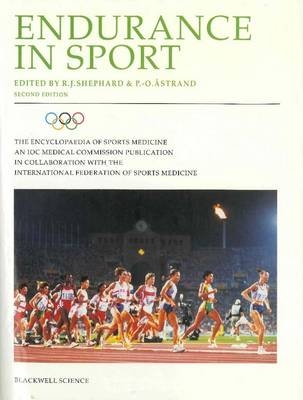
Endurance in Sport
Blackwell Science Ltd (Verlag)
978-0-632-05348-3 (ISBN)
- Keine Verlagsinformationen verfügbar
- Artikel merken
Endurance in Sport is a comprehensive and authoritative work on all aspects of this major component of sports science. The book also embraces medical and sport--specific issues of particular relevance to those interested in endurance performance. The scientific basis and mechanisms of endurance -- physiological, psychological, genetic and environmental -- are all considered in depth. Measurement of endurance is extensively reviewed as is preparation and training for physical activities requiring endurance.
R. J. Shephard is the editor of Endurance in Sport, 2nd Edition, published by Wiley. Per-Olof Astrand was a Swedish professor of physiology at the Royal Gymnastic Central Institute in Stockholm 1970-1977, and 1977-1988 at the Karolinska Institute in Stockholm, Sweden, and a member of the Nobel Assembly at Karolinska Institutet.
List of Contributors. Forewords. Preface to the First Edition. Preface to the Second Edition. PART 1: DEFINITIONS. 1. Semantic, biomechanical and physiological definitions. 2 Individual and team endurance sports. . PART 2: BASIC SCIENTIFIC CONSIDERATIONS. Part 2a: Biological Bases of Endurance Performance and the Associated Functional Capacities. 3 General considerations. 4 Anatomical and anthropometric bases of endurance. 5 Pulmonary system and endurance. . 6 Cardiac function and endurance. . 7 Muscle blood flow and endurance. . 8 Regulation of blood flow and endurance. 9 Cellular metabolism and endurance. . 10 Central nervous system and endurance. . 11 Muscular factors in endurance. . 12 Endocrine factors in endurance. 13 Food stores and energy reserves. Part 2b: Psychological Aspects of Endurance Performance. 14 Psychological aspects of endurance performance. Part 2c: Genetic Determinants of Endurance Performance. . 15 Genetic determinants of endurance performance. Part 2d: Physical Limitations of Endurance Performance. 16 Mechanical constraints and economy of movement in endurance. . 17 Endurance in hot and cold environments. PART 3: MEASUREMENT IN ENDURANCE SPORT. . 18 Factors to be measured. 19 Sport--specific testing in laboratory and field. 20 Assessment of environmental conditions. . 21 Maximal oxygen intake. 22 Muscular endurance, anaerobic threshold and blood lactate. . 23 Metabolism in the contracting skeletal muscle. 24 Body composition. 25 Personality structure. . 26 Effort perception. PART 4: PRINCIPLES OF ENDURANCE PREPARATION. 27 Influences of biological age and athletic selection. 28 Principles of endurance conditioning. . 29 Diet, vitamins and fluids before and after prolonged exercise. 30 Haemoglobin, blood volume and endurance. 31 Smoking, alcohol, ergogenic aids and doping. . 32 Psychological preparation. 33 Prevention of injuries in endurance athletes. 34 Monitoring for overtraining. PART 5: SPECIFIC POPULATION GROUPS AND ENDURANCE TRAINING. . 35 Endurance training and children. . 36 Endurance training and women. 37 Pregnant women and endurance exercise. 38 Endurance training and the elderly. 39 Endurance sport for persons with disability. PART 6: CLINICAL ASPECTS OF ENDURANCE TRAINING. . 40 Medical surveillance of endurance sport. 41 Pre--competitive examination of athletes. 42 Lung fluid movement in endurance sport. 43 Cardiovascular benefits of intensive exercise. . 44 Cardiovascular risks of intensive exercise. 45 Reproductive changes and the endurance athlete. 46 Endurance exercise and the immune response. 47 Hyperthermia, hypothermia and problems of hydration. 48 Problems of high altitudes. 49 Ambient air pollution and endurance competition. 50 Influence of time--zone shifts. 51 Health benefits of physical activity. 52 Overuse syndromes. 53 Countering excessive inflammation. PART 7: SPECIFIC ISSUES IN INDIVIDUAL AND TEAM SPORTS. 54 Energetics of running. 55 Swimming as an endurance sport. 56 Rowing. 57 Cross--country skiing. 58 Cycling. 59 Triathlon competition. 60 Canoeing. 61 Soccer and other team sports. 62 Mountaineering. 63 The Physiology of Human--Powered Flight. 64 Endurance in Other Sports. Index
| Erscheint lt. Verlag | 7.9.2000 |
|---|---|
| Reihe/Serie | The Encyclopaedia of Sports Medicine |
| Verlagsort | Oxford |
| Sprache | englisch |
| Maße | 191 x 256 mm |
| Gewicht | 1642 g |
| Themenwelt | Sachbuch/Ratgeber ► Sport |
| Medizin / Pharmazie ► Medizinische Fachgebiete ► Sportmedizin | |
| Studium ► 1. Studienabschnitt (Vorklinik) ► Physiologie | |
| Studium ► 2. Studienabschnitt (Klinik) ► Humangenetik | |
| ISBN-10 | 0-632-05348-8 / 0632053488 |
| ISBN-13 | 978-0-632-05348-3 / 9780632053483 |
| Zustand | Neuware |
| Haben Sie eine Frage zum Produkt? |
aus dem Bereich


